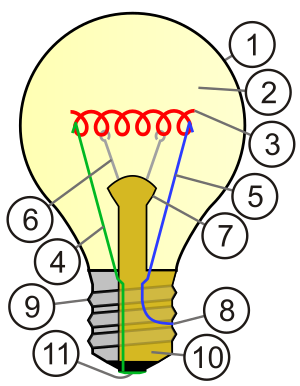" "
"
Light Bulb
 "
"As you see some parents, in the past, had a good explanation.
When I was young, at the age of seven, I asked to my father how a motor engine works. He explained with all the details. In that time I didn't understood too much, but years later at school I learned that topic faster than my colleagues.
So, don't be shine and explain as it is all the questions that your children have.
(click below to read the rest of the article)
(click below to read the rest of the article)
Light Bulb
The incandescent light bulb, incandescent lamp or incandescent light globe is a source of electric light that works by incandescence (a general term for heat-driven light emissions, which includes the simple case of black body radiation). An electric current passes through a thinfilament, heating it to a temperature that produces light. The enclosing glass bulb contains either a vacuum or an inert gas to prevent oxidation of the hot filament. Incandescent bulbs are also sometimes called electric lamps, a term also applied to the original arc lamps.
Incandescent bulbs are made in a wide range of sizes and voltages, from 1.5 volts to about 300 volts. They require no external regulating equipment and have a low manufacturing cost, and work well on either alternating current or direct current. As a result the incandescent lamp is widely used in household and commercial lighting, for portable lighting such as table lamps, car headlamps, and flashlights, and for decorative and advertising lighting.
Construction
Incandescent light bulbs consist of a glass enclosure (the envelope, or bulb) with a filament of tungsten wire inside the bulb, through which an electric current is passed. Contact wires and a base with two (or more) conductors provide electrical connections to the filament. Incandescent light bulbs usually contain a stem or glass mount anchored to the bulb's base which allows the electrical contacts to run through the envelope without gas/air leaks. Small wires embedded in the stem in turn support the filament and/or its lead wires. The bulb is filled with an inert gas such as argon to reduce evaporation of the filament.
An electrical current heats the filament to typically 2000 K to 3300 K (about 3100–5400°F), well below tungsten's melting point of 3695 K (6192°F). Filament temperatures depend on the filament type, shape, size, and amount of current drawn. The heated filament emits light that approximates a continuous spectrum. The useful part of the emitted energy is visible light, but most energy is given off as heat in the near-infrared wavelengths.
Three-way light bulbs have two filaments and three conducting contacts in their bases. The filaments share a common ground, and can be lit separately or together. Common wattages include 30–70–100, 50–100–150, and 100–200–300, with the first two numbers referring to the individual filaments, and the third giving the combined wattage.
While most light bulbs have clear or frosted glass, other kinds are also produced, including the various colors used for Christmas tree lights and other decorative lighting. Neodymium-containing glass is sometimes used to provide a more natural-appearing light.
|
Many arrangements of electrical contacts are used. Large lamps may have a screw base (one or more contacts at the tip, one at the shell) or a bayonet base (one or more contacts on the base, shell used as a contact or used only as a mechanical support). Some tubular lamps have an electrical contact at either end. Miniature lamps may have a wedge base and wire contacts, and some automotive and special purpose lamps have screw terminals for connection to wires. Contacts in the lamp socket allow the electric current to pass through the base to the filament. Power ratings for incandescent light bulbs range from about 0.1 watt to about 10,000 watts.
The glass bulb of a general service lamp can reach temperatures between 200 and 260 degrees Celsius (400 to 550 degrees Fahrenheit). Lamps intended for high power operation or used for heating purposes will have envelopes made of hard glass or fused quartz.
font: Wikipedia




No comments:
Post a Comment